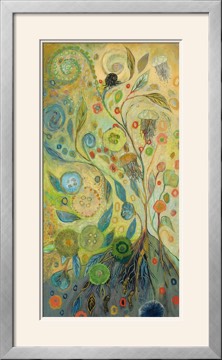When Art Is the Best Medicine
Hospitals are the work-horses of the building world. Rarely are they constructed with an eye to decadent style and design sophistication. Rather, they're built for utilitarian purposes: to house, support and employ a hive of life vs. death activity—24/7.
That's a lofty and important purpose.
However, in the last thirty years, countless studies have shown that art can soften the institutional feel of these imposing concrete structures, help combat the draining effects of persistent artificial light, reduce debilitating stress levels and even have a hand in healing.
This is about more than art for art's sake.

M.v. Wheelhouse,
In Scutari Florence Nightingale checks patients during the night
An Inside Job
On the grounds of hospitals participating in an arts renaissance, you'll often find evocative sculptural installations, well-tended flower gardens and sometimes even decorative ponds, alive with colorful Japanese Koi. These accents do more than make your entry to a high-anxiety environment more pleasant. They set the tone for your visit and speak to a hospital's overall commitment to care, which can result in a major win for public relations.
However, the real magic is happening on the inside. Because, unless you're getting elective surgery or having a baby (and even then, stress is still a huge factor), a visit to the hospital can be frightening. That's why austere corridors, bland cafeterias and tense waiting rooms have been enriched and enlivened with art that performs a surprising variety of functions.

Aleah Koury, Koi 2
Form and Function
It's not hard to imagine why Vincent Van Gogh's View of Arles with Irises might be a welcome distraction to someone being wheeled down an endless hallway on a squeaky gurney. It makes sense on an emotional level that Mary Cassatt's Mother and Child would be soothing for new moms in a maternity ward. It's even easy to comprehend why little ones would be so receptive to whimsical animal prints set to the tragic backdrop of a children's hospital.
But, it's the healing function of art that's most fascinating. And, it's not just conjecture. There are cold, hard facts to back the notion that art has a physical and emotional impact on patients, visitors and staff:

David Newton, The Clearing
A study by Roger S. Ulrich for the American Association for the Advancement of Science, found that “[Surgery patients] who saw trees recuperated almost a full day faster and required fewer doses of pain medication than those facing a brick wall.” (No, you don't need to start demoing walls and planting fast-growing saplings. A framed forested print will suffice.)
According to an Americans for the Arts study, 78% of healthcare facilities delivering on some form of arts programming have cited measurable benefits to patients, including shorter hospital stays, better pain management and less medication.
A comprehensive survey performed by The Cleveland Clinic revealed that 73% of respondents found the hospital's contemporary art collection to be calming, and more than 60% reported a reduction in stress.
According to a 2011 University of London study, viewing beautiful art increases blood flow to what's known as the "joy response" part of the brain. Thus, viewing a beautiful piece of art can alter your physiology or change your mind.
Of course, beauty is entirely subjective, and in the proverbial eye of the beholder. But, it's not difficult to select art that pleases a wide array of artistic palates.

Jennifer Lommers, Embracing the Journey
Framing the Feeling
Much of the research about the impact of art in hospital settings tends to also reveal optimal genres, colors and subject matter. A survey conducted in Italy involving 345 cancer patients suggests that healing stems from exposure to lush, serene landscapes, tranquil water scenes and emotionally expressive pieces featuring warm pops of color and happy people doing ordinary things. This representation of normalcy can instill a great deal of hope and optimism in a patient battling for their life.
As you might suspect, evidence also suggests that aggressive abstract art or something like Picasso's Weeping Woman would be far too triggering for a hospital environment. In fact, steer clear of any pieces that might seem confusing or unsettling to someone who's not well.
The right art should emotionally connect patients, visitors and staff with the life awaiting them on the outside of what can be a jarring and surreal microcosm. And, if the subject matter is universal in nature, it can even help bridge cultural gaps and engender a feeling of oneness—something our fractured society can certainly benefit from.

Frank Lukasseck, Path Winding Through Beech Forest and Bluebells
Justifying the Cost
If you're concerned that there's no budget for the arts in healthcare, consider this, according to an Americans for the Arts report, nearly half of the nation's healthcare institutions provide arts programming not just for patients, but for families and even staff. Also, 40% of veteran's medical centers have rotating art exhibitions, permanent art collections, commissioned paintings or sculptures.
Hospitals simply can't afford the detrimental effects of bare walls. There's too much research and data to support the fact that art is integral to the healing process and the well-being of visitors and individuals working in these high-stress environments.
We're never returning to an era of sterile corridors and blank, brick walls. This humanistic approach to healing and well-being is thriving and gaining momentum. You might call it the (healing) wave of the future.
Suffice it to say, art is no longer a “Wow, this reception room is stark” afterthought. It's being built into hospital budgets, worldwide. Granted, not every facility will be able to afford the breadth and depth of work on display at the renowned Cleveland Clinic, but the experts at Art.com's WorkspaceArt division can help you assemble a collection that reflects your hospital's mission and works for your budget.

Ursula Abresch, Blue Lagoon